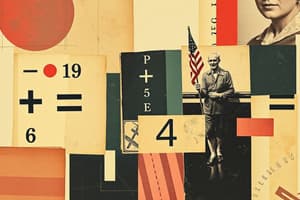Podcast
Questions and Answers
What is one advantage of using a number line for addition?
What is one advantage of using a number line for addition?
- It helps in estimating large results accurately
- It allows for regrouping numbers easily
- It simplifies complex addition problems instantly
- It shows how far away numbers are from zero (correct)
When adding three or more numbers, which technique involves breaking down groups within larger sums into individual parts?
When adding three or more numbers, which technique involves breaking down groups within larger sums into individual parts?
- Regrouping (correct)
- Carrying over
- Estimation
- Rounding off
How does estimation play a role in mastering addition?
How does estimation play a role in mastering addition?
- It simplifies regrouping of numbers during addition
- It leads to exact and precise calculation results
- It eliminates the need for carrying over numbers
- It helps in mentally visualizing the work needed for solving equations (correct)
What is a common strategy used when adding three or more numbers?
What is a common strategy used when adding three or more numbers?
Which technique is useful for estimating large results in addition by ensuring they stay within certain boundaries?
Which technique is useful for estimating large results in addition by ensuring they stay within certain boundaries?
What is the purpose of carrying over in addition?
What is the purpose of carrying over in addition?
In the context of adding 9+17 with carrying over, what number would be left behind in the ones column after carrying over?
In the context of adding 9+17 with carrying over, what number would be left behind in the ones column after carrying over?
How does applying estimation help in word problems involving addition?
How does applying estimation help in word problems involving addition?
When adding three or more numbers together, what is a common approach to avoid errors?
When adding three or more numbers together, what is a common approach to avoid errors?
How can number lines be beneficial in helping children understand addition?
How can number lines be beneficial in helping children understand addition?
Flashcards are hidden until you start studying
Study Notes
Addition is one of the four basic operations we learn in elementary mathematics. It involves combining two quantities by placing them side by side so they can be counted together. There are several ways to approach this operation depending on what you're adding up and how many numbers there are involved.
One common method is called carrying over. This occurs when you have a column where all digits are nine, meaning that ten ones were put into it plus another one from the next column. To show this, you would draw a small line above each digit in its place in the big circle, which indicates something extra added. From now on, this would count for ten units instead of just one unit like before. So if you had 9+17=9 in a column and wanted to carry over, you would draw a little line above the seven, indicating that twelve went out of the column and into the tens space, with only six left behind.
Word problems involving addition often require us to apply our understanding of what we know about adding things together. For example, imagine two piles of apples and oranges sitting on top of each other. If you want to find out how many total fruits there are, your task might involve adding both sets of fruit to see their combined weight or quantity.
Using number lines for addition is also important because once you understand the concept of a number line, every single time you do any type of math problem, whether it's multiplication or division or whatever else, you will always start off thinking of it along a number line somewhere in your brain. A number line shows us how far away different numbers are from zero - the further right they get on the line, the bigger the number becomes; while moving towards the center represents smaller numbers.
Adding three or more numbers usually requires some kind of strategy that depends on the size and complexity of the numbers being added together. One common technique is called regrouping, which means taking note of groups within larger sums that need to be broken down into individual parts before performing the actual calculation. Another useful tactic is called rounding off, which allows us to estimate large results by making sure they fall within certain predetermined boundaries.
Estimation is essential in learning addition because even though we don't necessarily use estimations every day when doing simple arithmetic, applying estimates helps make calculations easier. Estimates give you a sense of how much work goes into solving particular types of equations, like figuring out how many minutes someone spends watching television - it gives you an idea without having to perform exact calculations, helping develop mental maturity toward abstract concepts such as measurement.
In conclusion, mastering addition involves various techniques such as carrying over, working through word problems, employing strategies during complex sums, and utilizing estimation to simplify difficult tasks. These skills build upon one another, allowing us to become better equipped for handling mathematical challenges throughout life.
Studying That Suits You
Use AI to generate personalized quizzes and flashcards to suit your learning preferences.



